Poole Ch.P., Jr. Handbook of Superconductivity
Подождите немного. Документ загружается.

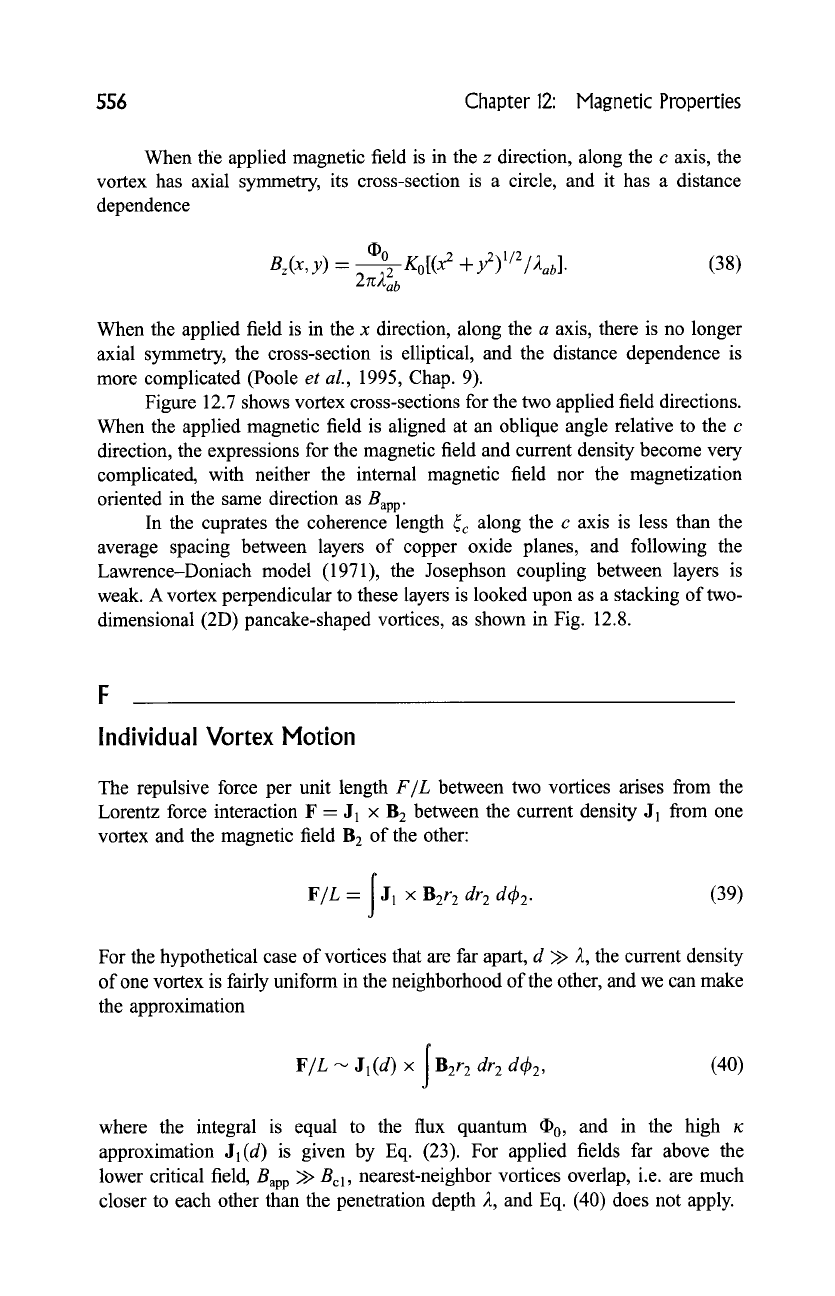
556
Chapter
12: Magnetic
Properties
When the applied magnetic field is in the z direction, along the c axis, the
vortex has axial symmetry, its cross-section is a circle, and it has a distance
dependence
Oo
Oz(x, Y) -- 2g~2ab /2/~ab]"
(38)
When the applied field is in the x direction, along the a axis, there is no longer
axial symmetry, the cross-section is elliptical, and the distance dependence is
more complicated (Poole et al., 1995, Chap. 9).
Figure 12.7 shows vortex cross-sections for the two applied field directions.
When the applied magnetic field is aligned at an oblique angle relative to the c
direction, the expressions for the magnetic field and current density become very
complicated, with neither the internal magnetic field nor the magnetization
oriented in the same direction as Bap p.
In the cuprates the coherence length ~c along the c axis is less than the
average spacing between layers of copper oxide planes, and following the
Lawrence-Doniach model (1971), the Josephson coupling between layers is
weak. A vortex perpendicular to these layers is looked upon as a stacking of two-
dimensional (2D) pancake-shaped vortices, as shown in Fig. 12.8.
Individual Vortex Motion
The repulsive force per unit length F/L between two vortices arises from the
Lorentz force interaction F -- J1 x B2 between the current density J1 from one
vortex and the magnetic field B 2 of the other:
F/L- I J1 • B2r2 dr2 d~b2.
(39)
For the hypothetical case of vortices that are far apart, d >> 2, the current density
of one vortex is fairly uniform in the neighborhood of the other, and we can make
the approximation
F/L ~ Jl(d) • I B2r2 dr2 dq~2'
(40)
where the integral is equal to the flux quantum O0, and in the high ~c
approximation Jl(d) is given by Eq. (23). For applied fields far above the
lower critical field, Bap p >> Be1, nearest-neighbor vortices overlap, i.e. are much
closer to each other than the penetration depth 2, and Eq. (40) does not apply.
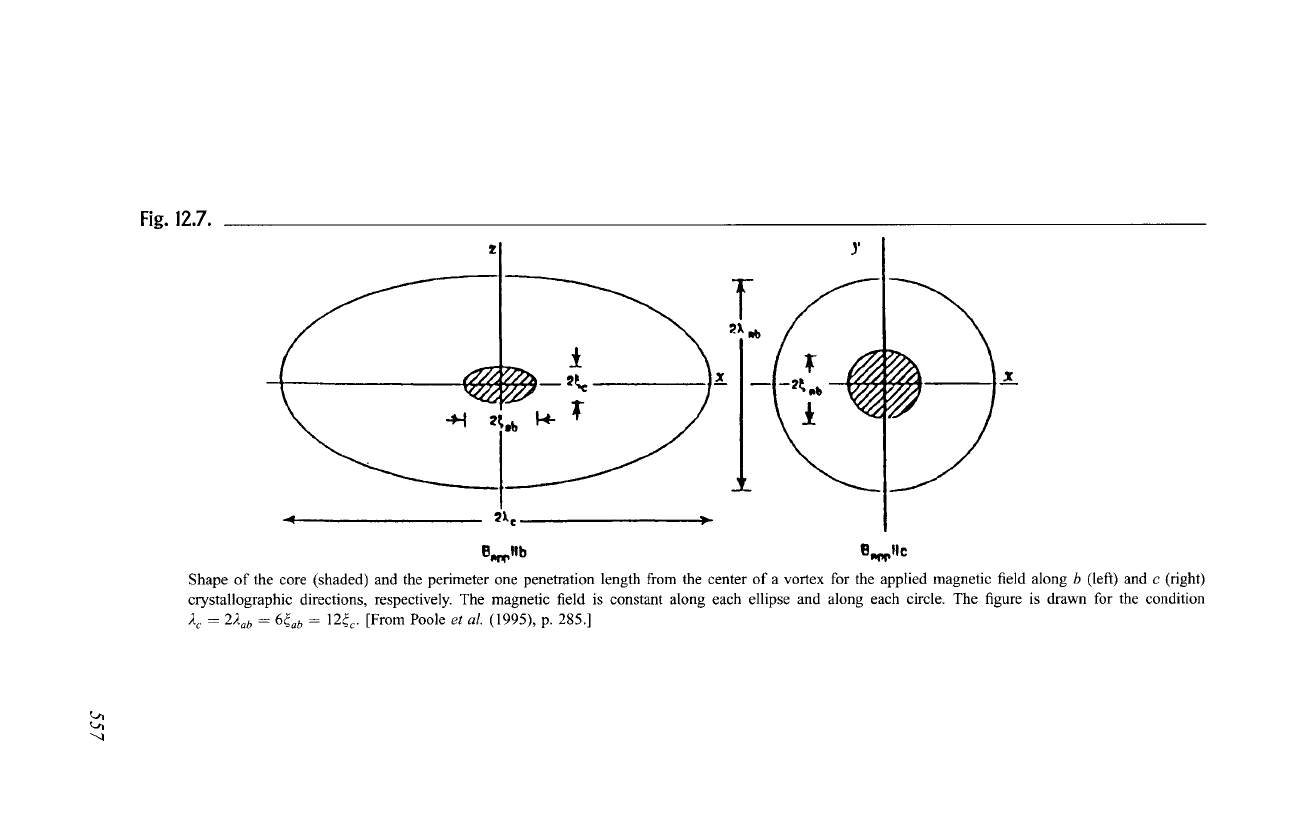
Fig. 12.7.
/
-
,
,
,
2), e
_
,,
B~II5 B~IIc
Shape of the core (shaded) and the perimeter one penetration length from the center of a vortex for the applied magnetic field along b (left) and c (right)
crystallographic directions, respectively. The magnetic field is constant along each ellipse and along each circle. The figure is drawn for the condition
2 c -- 22ab
= 6~ab = 12~ c. [From Poole
et al.
(1995), p. 285.]
"-1
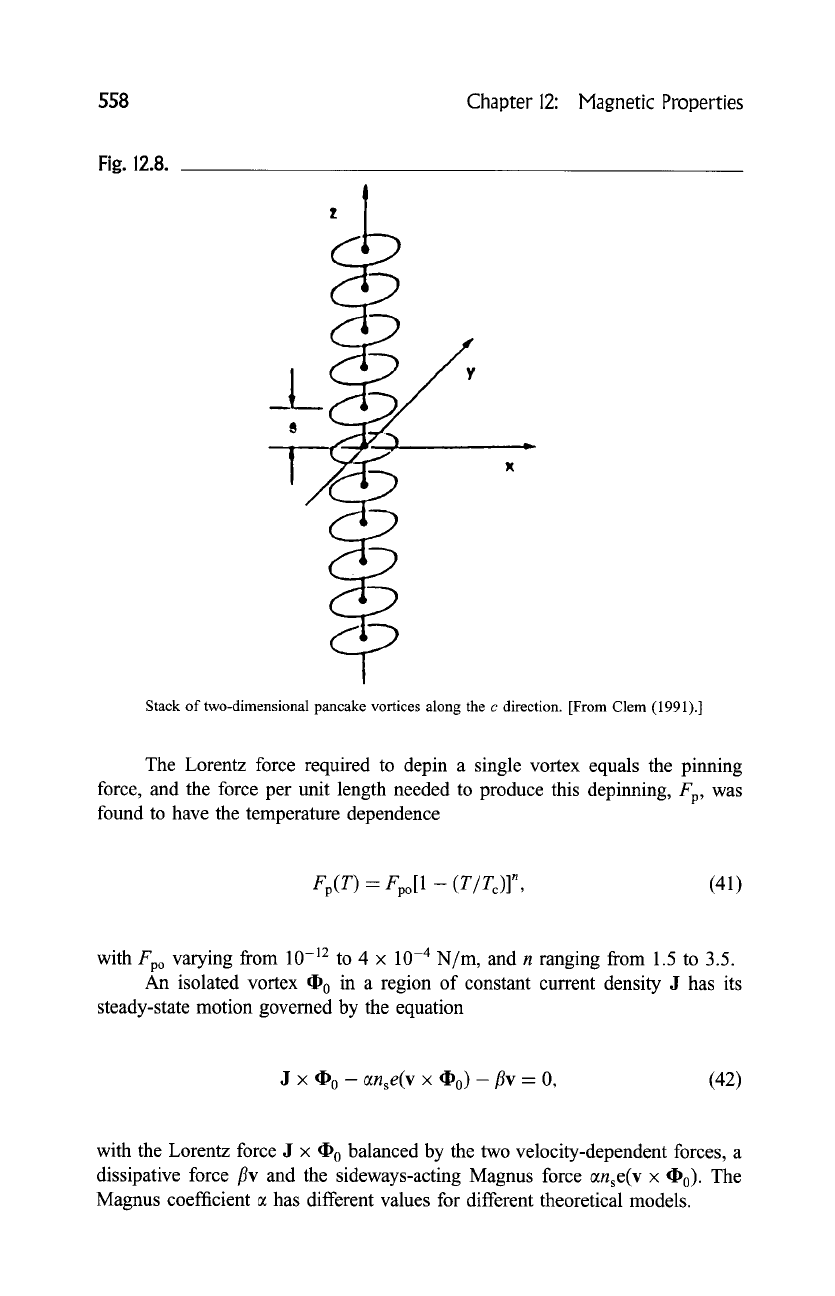
558
Chapter
12:
Magnetic Properties
Fig. 12.8.
2
C)
--] ___~
Y
$
C
C.
C
1
v
Stack of two-dimensional pancake vortices along the c direction. [From Clem (1991).]
The Lorentz force required to depin a single vortex equals the pinning
force, and the force per unit length needed to produce this depinning, Fp, was
found to have the temperature dependence
Fo(T ) - Fpo[1
-
(T/Tc)] n,
(41)
with Fpo varying from 10
-12
to 4 x 10
-4
N/m, and n ranging from 1.5 to 3.5.
An isolated vortex ~0 in a region of constant current density J has its
steady-state motion governed by the equation
J x ~o - ~nse(V x ~0) -flv - 0,
(42)
with the Lorentz force J x ~0 balanced by the two velocity-dependent forces, a
dissipative force/~v and the sideways-acting Magnus force ense(V x ~o)- The
Magnus coefficient e has different values for different theoretical models.
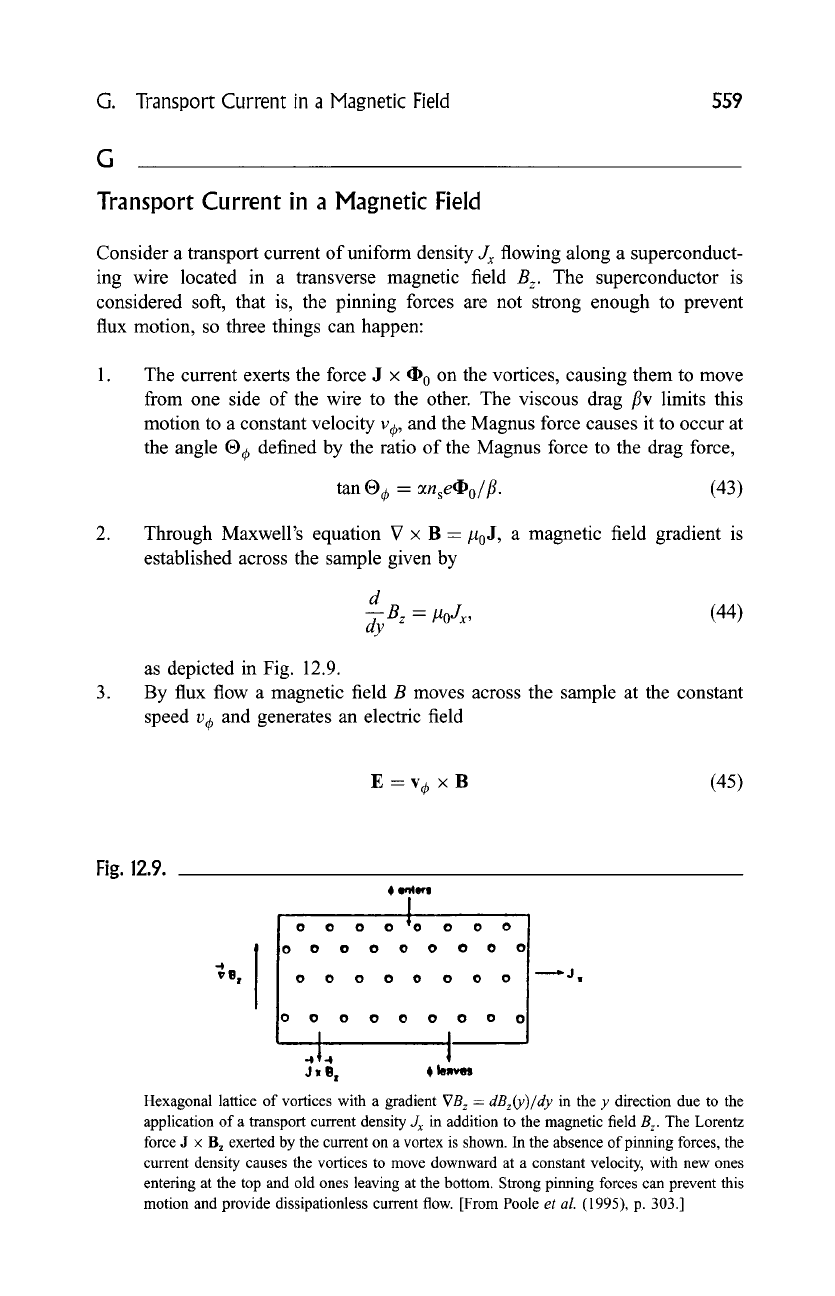
G. Transport Current in a Magnetic Field
559
G
Transport Current in a Magnetic Field
Consider a transport current of uniform density
Jx
flowing along a superconduct-
ing wire located in a transverse magnetic field
B z.
The superconductor is
considered soft, that is, the pinning forces are not strong enough to prevent
flux motion, so three things can happen:
.
The current exerts the force J x ~0 on the vortices, causing them to move
from one side of the wire to the other. The viscous drag /~v limits this
motion to a constant velocity v~, and the Magnus force causes it to occur at
the angle | defined by the ratio of the Magnus force to the drag force,
tan | =
Cmse~o/,6.
(43)
Through Maxwell's equation V x B = #0 J, a magnetic field gradient is
established across the sample given by
d
-- B z = #OJx,
(44)
dy
as depicted in Fig. 12.9.
By flux flow a magnetic field B moves across the sample at the constant
speed v~ and generates an electric field
E - v~ x B (45)
Fig. 12.9.
.4
vgj
6 er~ere
0 0 0 0 I0 0 0 0
0 0 0 0 0 0 0 0
0 0 0 0 0 0 0 0 0 --'~J ~
0 0 0 0 0 0 0
'
t
J ~ gt 0 tm.,es
Hexagonal lattice of vortices with a gradient
VB z = dBz(y)ldy
in the y direction due to the
application of a transport current density
Jx
in addition to the magnetic field
B z.
The Lorentz
force J • B z exerted by the current on a vortex is shown. In the absence of pinning forces, the
current density causes the vortices to move downward at a constant velocity, with new ones
entering at the top and old ones leaving at the bottom. Strong pinning forces can prevent this
motion and provide dissipationless current flow. [From Poole
et al.
(1995), p. 303.]
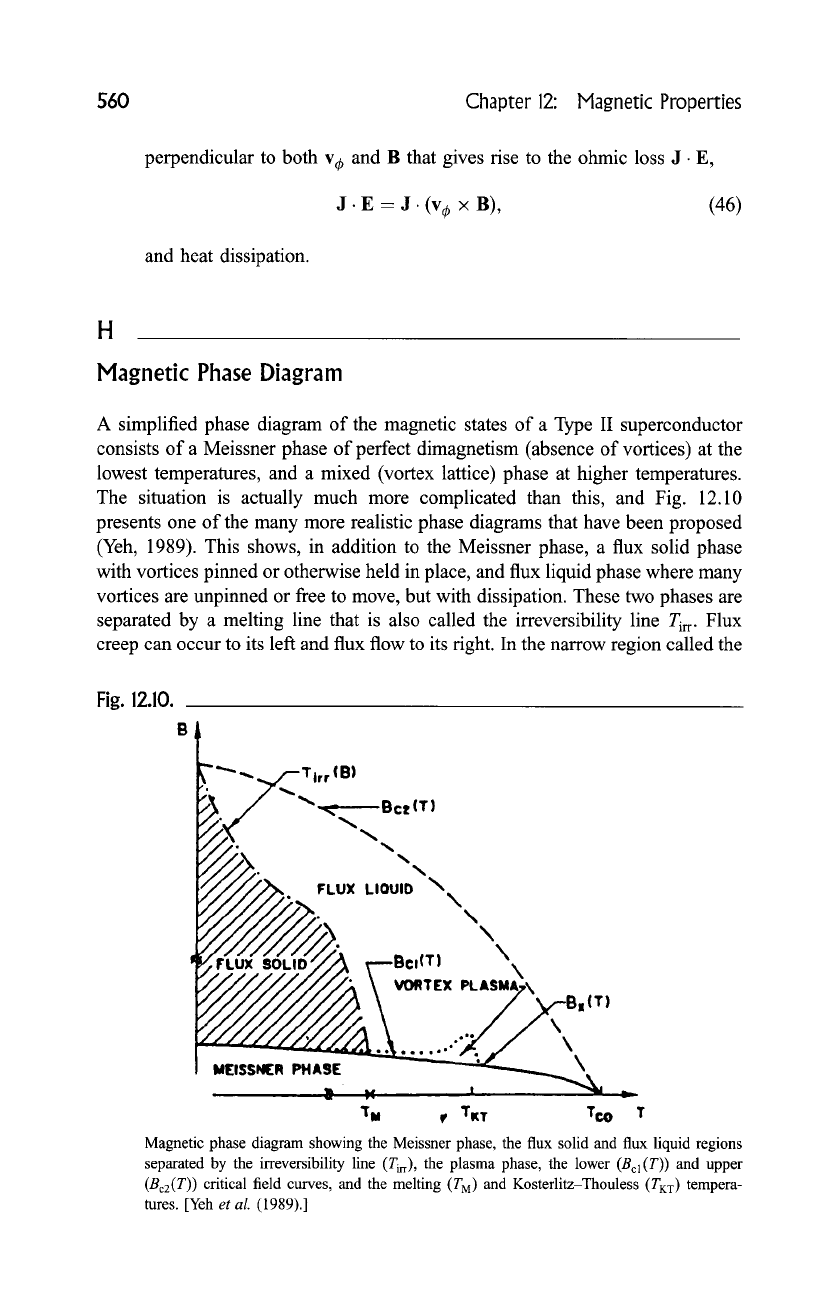
560 Chapter 12: Magnetic Properties
perpendicular to both v~ and B that gives rise to the ohmic loss J. E,
J.E-J.(v~xB),
(46)
and heat dissipation.
H
Magnetic Phase Diagram
A simplified phase diagram of the magnetic states of a Type II superconductor
consists of a Meissner phase of perfect dimagnetism (absence of vortices) at the
lowest temperatures, and a mixed (vortex lattice) phase at higher temperatures.
The situation is actually much more complicated than this, and Fig. 12.10
presents one of the many more realistic phase diagrams that have been proposed
(Yeh, 1989). This shows, in addition to the Meissner phase, a flux solid phase
with vortices pinned or otherwise held in place, and flux liquid phase where many
vortices are unpinned or free to move, but with dissipation. These two phases are
separated by a melting line that is also called the irreversibility line Tir r. Flux
creep can occur to its left and flux flow to its fight. In the narrow region called the
Fig. 12.10.
|rr
(B)
FLUX SOLID
~',~------Bct (T)
FLUX LIOUID ~
",,
/ Bc
\
VORTEX PLASMA,
MEISSN(R PHASE
e 9 9
Oe~
~-Bx(T)
\
\
\
"I'M I, TKT TCO T
Magnetic phase diagram showing the Meissner phase, the flux solid and flux liquid regions
separated by the irreversibility line (Tirr), the plasma phase, the lower (Bcl(T)) and upper
(Bc2(T)) critical field curves, and the melting (TM) and Kosterlitz-Thouless (TKT) tempera-
tures. [Yeh
et al.
(1989).]
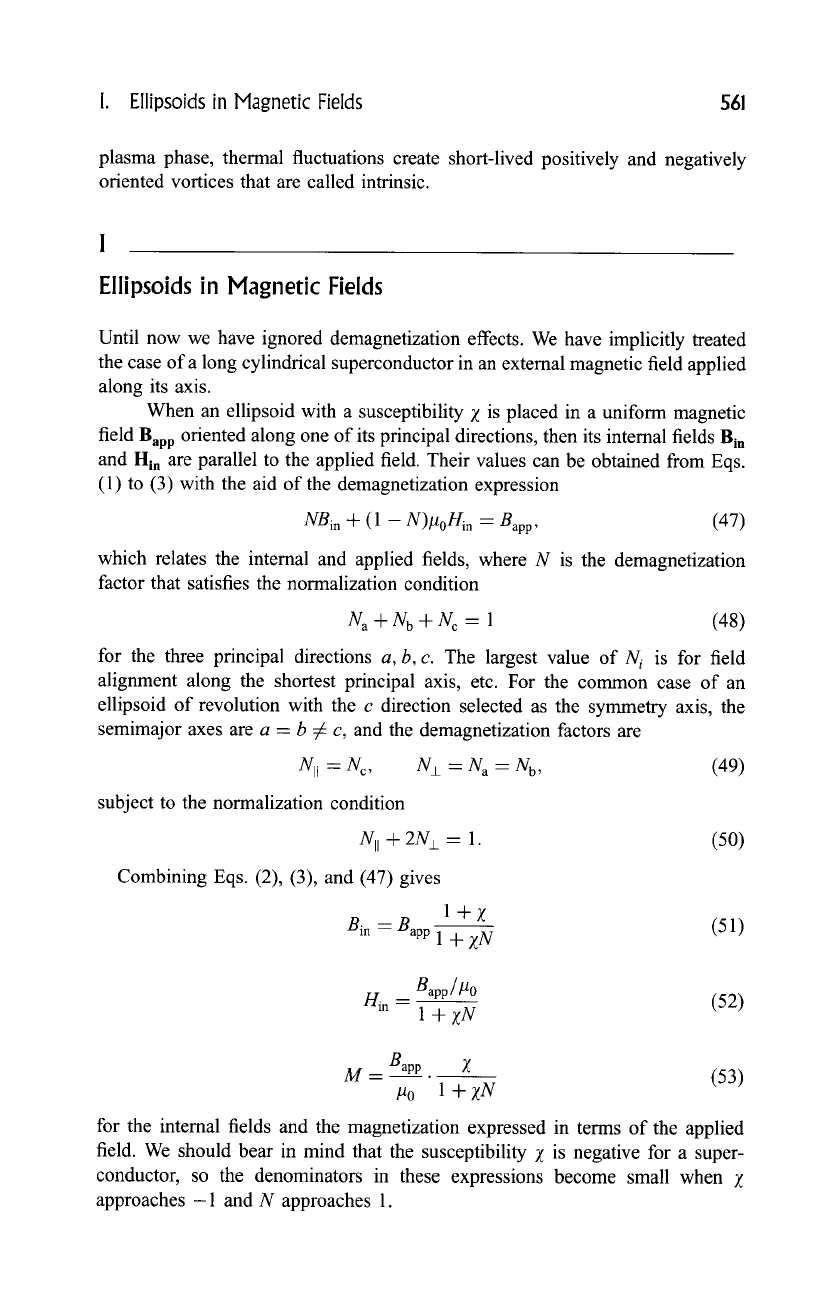
I. Ellipsoids in Magnetic Fields
561
plasma phase, thermal fluctuations create short-lived positively and negatively
oriented vortices that are called intrinsic.
Ellipsoids in Magnetic Fields
Until now we have ignored demagnetization effects. We have implicitly treated
the case of a long cylindrical superconductor in an extemal magnetic field applied
along its axis.
When an ellipsoid with a susceptibility Z is placed in a uniform magnetic
field Bap p oriented along one of its principal directions, then its intemal fields
Bin
and Hi. are parallel to the applied field. Their values can be obtained from Eqs.
(1) to (3) with the aid of the demagnetization expression
NBin + (1 - N)laoHin = Bapp, (47)
which relates the internal and applied fields, where N is the demagnetization
factor that satisfies the normalization condition
N a +N b +N c = 1 (48)
for the three principal directions a, b, c. The largest value of N/ is for field
alignment along the shortest principal axis, etc. For the common case of an
ellipsoid of revolution with the c direction selected as the symmetry axis, the
semimajor axes are a - b :/: c, and the demagnetization factors are
Nil -- N c, N_L = N a -- N b, (49)
subject to the normalization condition
Nil + 2N• = 1. (50)
Combining Eqs. (2), (3), and (47) gives
I+X
Bin
--
Bapp 1 + zN (51)
Bin - Bapp//to
1 + zN (52)
M
-
Bapp X
~. (53)
#o 1
+ zN
for the internal fields and the magnetization expressed in terms of the applied
field. We should bear in mind that the susceptibility Z is negative for a super-
conductor, so the denominators in these expressions become small when Z
approaches-1 and N approaches 1.
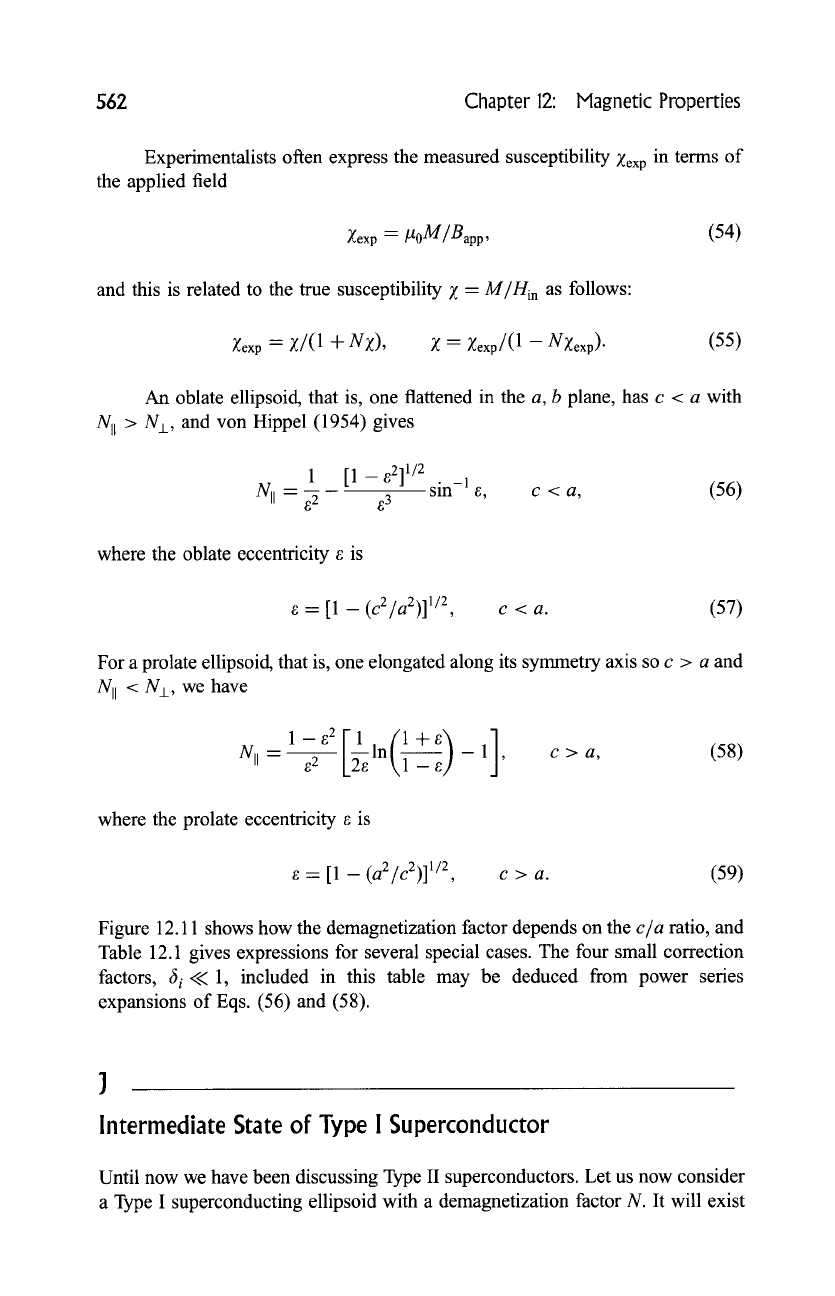
562 Chapter 12: Magnetic Properties
Experimentalists often express the measured susceptibility
~exp
in terms of
the applied field
Zexp -
#oM/Bapp,
(54)
and this is related to the true susceptibility Z-
M/Hin
as follows:
Zexp --
Z/(1
+
NZ), Z -
Zexp/( 1 - NZexp)- (55)
An oblate ellipsoid, that is, one flattened in the a, b plane, has c < a with
Nil > N• and von Hippel (1954) gives
1 [1
-- 82] 1/2
Nil
=/32 /33
sin -1 e, c < a, (56)
where the oblate eccentricity e is
~; -- [1 --
(c2/a2)] 1/2,
c < a.
(57)
For a prolate ellipsoid, that is, one elongated along its symmetry axis so c > a and
Nil < N• we have
NIl- e2 ~ln _ - 1 , c > a, (58)
where the prolate eccentricity e is
e -[1 -(a2/c2)]
1/2, c > a.
(59)
Figure 12.11 shows how the demagnetization factor depends on the
c/a
ratio, and
Table 12.1 gives expressions for several special cases. The four small correction
factors,
~i (( 1,
included in this table may be deduced from power series
expansions of Eqs. (56) and (58).
Intermediate State of Type ! Superconductor
Until now we have been discussing Type II superconductors. Let us now consider
a Type I superconducting ellipsoid with a demagnetization factor N. It will exist
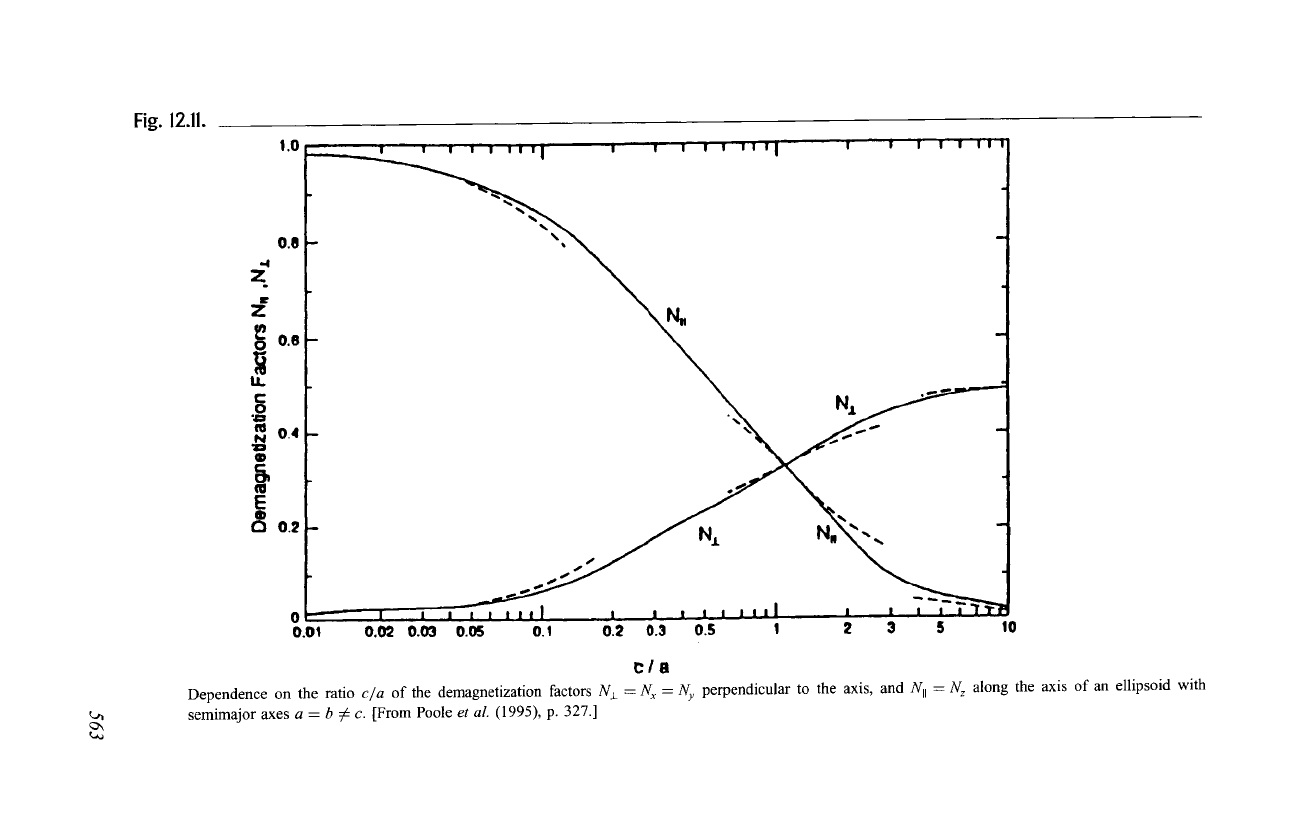
Fig. 12.11.
1.0
_r'"
.'" 9 , w li l|
0.0
,,4
z
=,
z
0 0.6
C
O
aS 0.4
N
~D
Q
g
m
E
O
o o2
J
J
~J
N~
N.'~-.
,= ,,s
. . , , ,j_,_]_ , ,. . , , ,..i . , _'
+"~,,,
_
o.os o.o2 o.o3 o.os o.t 0.2- o.s O.s t 2 s s to
Dependence on the Patio e/+ of the demagnetization factors Nj_ = N+ -- Ny perpendicular to the axis, and Nit = N+ along the axis of an ellipsoid with
semimajo+ axes + = + :~ e. [Prom Poole
et
+l. C1995), p. 32?.]
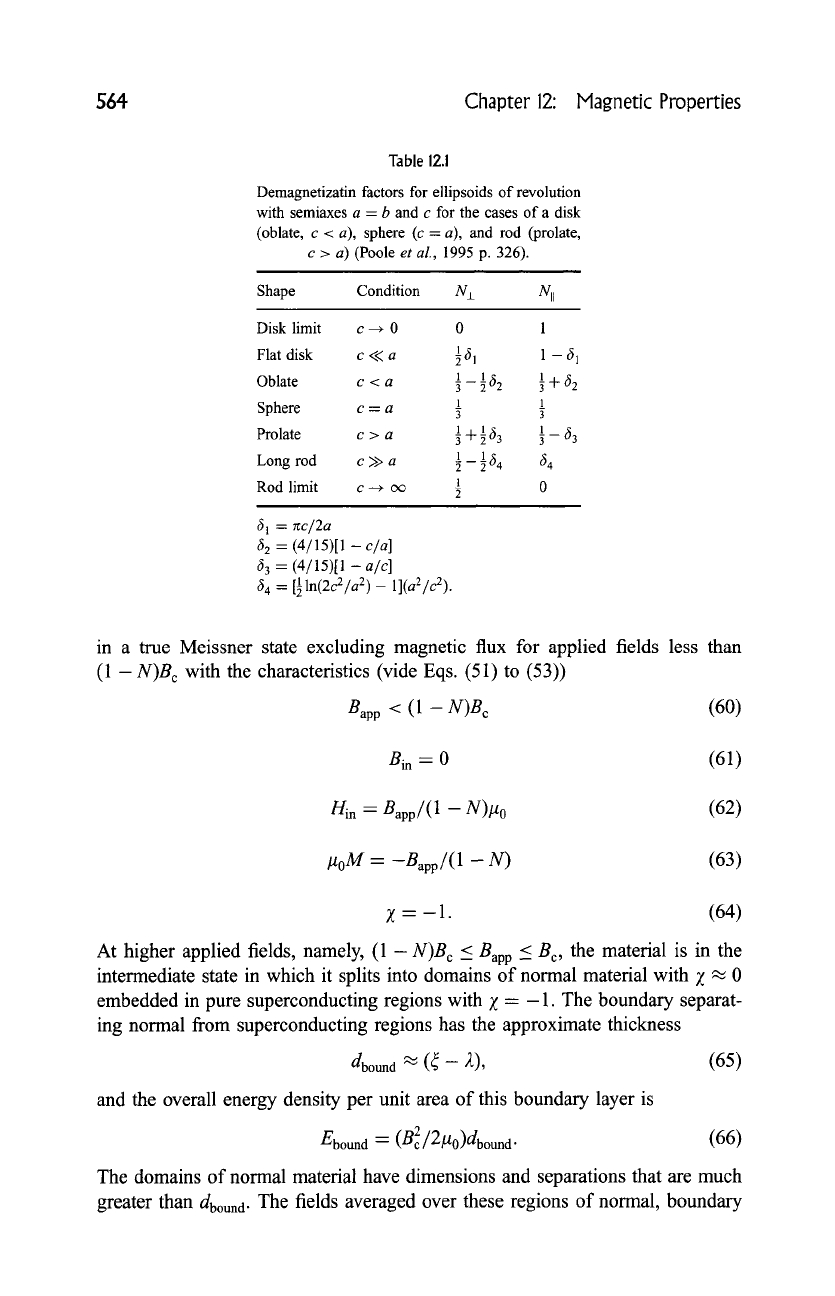
564
Chapter 12: Magnetic Properties
Table 12.1
Demagnetizatin factors for ellipsoids of revolution
with semiaxes a = b and c for the cases of a disk
(oblate, c < a), sphere (c = a), and rod (prolate,
c > a) (Poole
et al.,
1995 p. 326).
Shape Condition N• Nil
Disk limit c ~ 0 0
Flat disk c << a 89 61
1
89
Oblate c < a 3
1
Sphere c = a
Prolate c > a 1
+ 163
1
164
Long rod c >> a 2
1
Rod limit c -+ oo
1
1
--61
1+6 2
1
_
3
~-63
64
0
61 = xc/2a
32 = (4/15)[1 --
c/a]
63 = (4/15)[1 -
a/c]
64 = [1 ln(2c 2/a
2) _
1](a 2/c2).
in a true Meissner state excluding magnetic flux for applied fields less than
(1 -N)B
c
with the characteristics (vide Eqs. (51) to (53))
Bap p <
(1 -
N)B c
(60)
Bin --0 (61)
Hin --
Bapp/(1 - N)# 0
(62)
p0 M
-- -Bap p/(1
- N)
(63)
Z = -1. (64)
At higher applied fields, namely, (1 -N)B
c <_
Bap p < Bc, the material is in the
intermediate state in which it splits into domains of normal material with Z ~ 0
embedded in pure superconducting regions with Z - -1. The boundary separat-
ing normal from superconducting regions has the approximate thickness
dboun d ~ (~ - 2), (65)
and the overall energy density per unit area of this boundary layer is
-- (Bc /21.to)dboun d.
(66)
gbound 2
The domains of normal material have dimensions and separations that are much
greater than dboun d. The fields averaged over these regions of normal, boundary
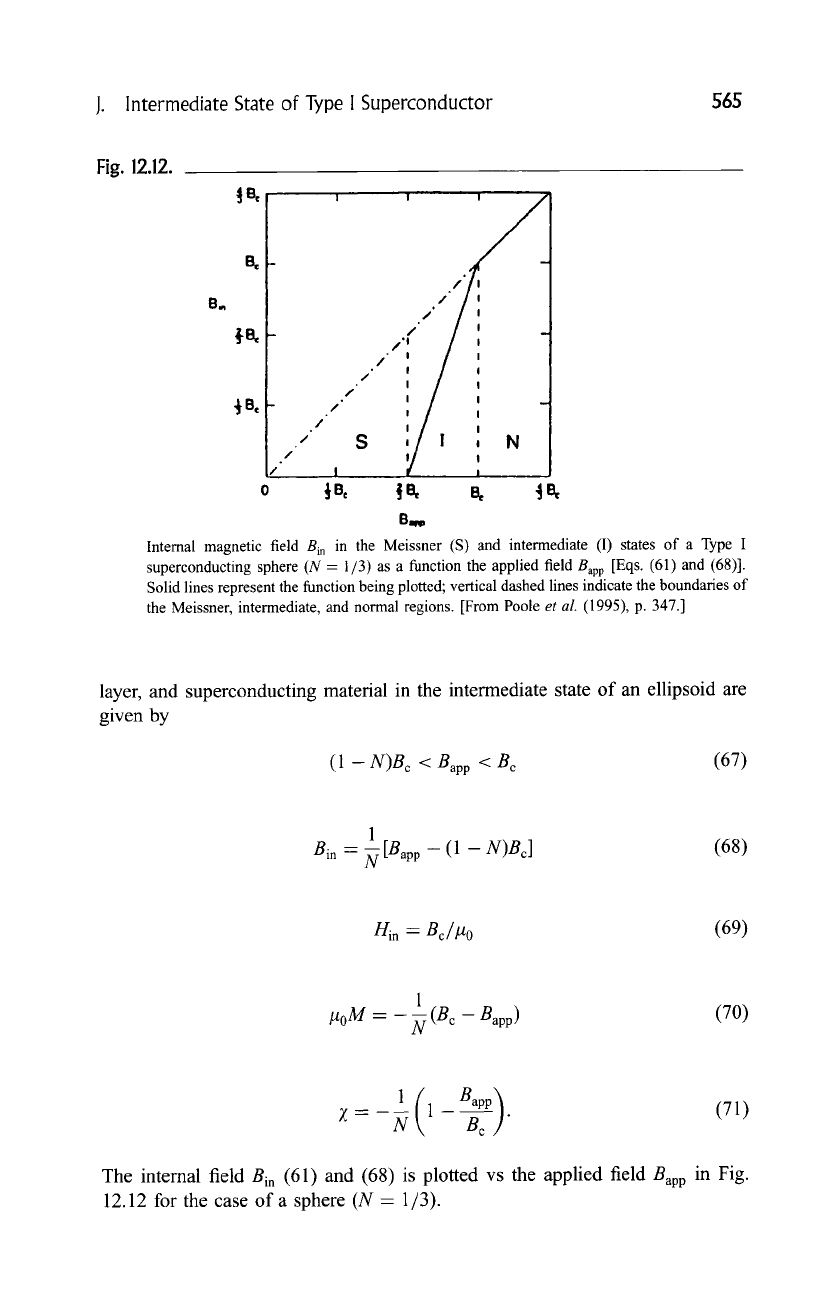
J. Intermediate State of Type I Superconductor
565
Fig. 12.12.
B.
,JB,-
/
/
0
,
/
f
/
/
s
!
"/i
/" !
_
/'1
/" I I
! !
I !
I I _
I I
I I
I .. , I
Internal magnetic field Bm in the Meissner (S) and intermediate (I) states of a Type I
superconducting sphere (N = 1/3) as a function the applied field Bap p [Eqs. (61) and (68)].
Solid lines represent the function being plotted; vertical dashed lines indicate the boundaries of
the Meissner, intermediate, and normal regions. [From Poole
et al.
(1995), p. 347.]
layer, and superconducting material in the intermediate state of an ellipsoid are
given by
(1 -N)B c
< Bap p <
B c
(67)
1
Bin -- ~ [Map p -
(1
- N)Bc] (68)
Hin -
Bc/]l 0
(69)
1
p0 M -- - ~ (B c
- Bapp)
(70)
1( Bapp~ (71)
Z--~ 1-Bc/.
The internal field
Bin
(61) and (68) is plotted vs the applied field
Bap p
in Fig.
12.12 for the case of a sphere (N - 1/3).
